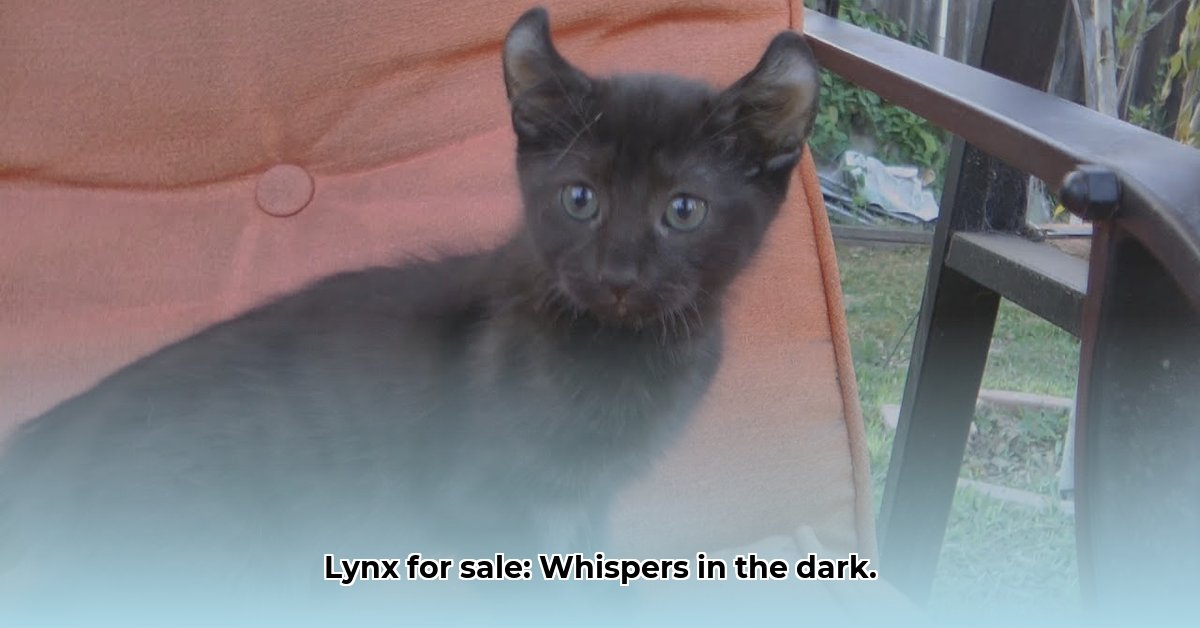The discovery of four lynx in the Scottish Highlands in early 2025 sparked an investigation into the shadowy world of the black market lynx trade. Their presence, far from their native habitats, suggests a disturbing connection to the illegal exotic pet trade and raises critical questions about the dangers, legalities, and devastating consequences of owning these wild animals.
The Scottish Lynx Mystery: Unraveling the Clues
The appearance of four lynx—two near Kingussie and two in Cairngorms National Park—immediately raised red flags. Escaped from a zoo? Highly unlikely. A deliberate release? A more probable scenario. Authorities suspect these lynx were once part of the illegal exotic pet trade, either intentionally released or having escaped captivity. The Royal Zoological Society of Scotland (RZSS), currently caring for the lynx at Edinburgh Zoo, is working to determine their origins through genetic testing and other investigations. This incident underscores the complexities of wildlife management and the challenges posed by the illegal exotic pet trade. It also adds another layer of complexity to the ongoing debate about the potential reintroduction of lynx to Scotland, raising concerns about rogue rewilding attempts or even deliberate sabotage of official efforts.
The Global Lynx Trade: A Shadowy Network
The Scottish incident offers a glimpse into the broader, more disturbing reality of the global lynx trade. This illicit network, driven by demand for lynx fur, claws, and even live animals, spans continents, making it incredibly challenging to track. Poaching, often occurring in Eastern Europe, Russia, and Central Asia, fuels the supply, while demand largely originates from wealthy nations in Western Europe, North America, and increasingly, Asia. This illegal activity decimates wild lynx populations, disrupts fragile ecosystems, and pushes some species, including the Eurasian lynx, Iberian lynx, Canada lynx, and Bobcat, closer to extinction. Organized crime is likely involved, further complicating efforts to dismantle this cruel trade.
The Price of an Exotic Whisker: The Economics of the Black Market
Determining the exact price of a black market lynx is like trying to catch smoke – elusive and ever-shifting. Factors like subspecies (Eurasian vs. Canadian), age (cub vs. adult), and the specific black market network involved all influence the final cost, which can range from thousands to tens of thousands of dollars. Researchers often resort to investigating dark web marketplaces and analyzing reports from wildlife trafficking busts to glean insights into this secretive market. However, obtaining precise figures remains a challenge. The high price tag reflects the rarity of these animals, the difficulty of acquiring them, and the perceived status associated with owning such an exotic pet.
Why Lynx? The Allure and the Danger
The desire to own a lynx likely stems from a combination of factors. For some, it’s the allure of the exotic, the status symbol of possessing a rare and beautiful creature. Others may harbor a misguided belief that they are rescuing the animal, offering it a better life than it would have in the wild. However, this romanticized view ignores the inherent dangers and ethical concerns associated with keeping a wild predator in captivity. Lynx are not domesticated animals; they possess sharp claws, powerful jaws, and deeply ingrained predatory instincts that pose significant risks to both the animal and the owner. Moreover, their complex needs are virtually impossible to meet in a typical home environment, leading to suffering and behavioral problems for the lynx.
The Real Cost of Owning a Lynx: Beyond the Price Tag
The true cost of a black market lynx extends far beyond the hefty price tag. It encompasses the suffering inflicted on the animal, ripped from its natural habitat or born into a life of confinement. It includes the devastating impact on wild populations, already facing threats from habitat loss and other pressures. And it contributes to the perpetuation of a cruel and illegal global trade network that prioritizes profit over animal welfare and ecological balance.
What You Can Do: Taking Action Against the Lynx Trade
The fight against the black market lynx trade requires a collective effort. Here’s how you can make a difference:
- Educate yourself: Learn about the realities of the exotic pet trade and its impact on lynx and other endangered species.
- Support conservation: Donate to or volunteer with reputable organizations dedicated to protecting lynx and their habitats, such as the International Union for Conservation of Nature (IUCN) Cat Specialist Group.
- Report suspicious activity: If you encounter any suspicious activity related to the illegal wildlife trade, report it to the appropriate authorities, like the U.S. Fish and Wildlife Service, or if in the UK The Royal Society for the Protection of Birds (RSPB).
- Spread the word: Share this information with your friends, family, and social networks to raise awareness about the issue.
The future of lynx, and indeed the health of our planet, depends on our collective action. By working together, we can help ensure that these magnificent creatures remain in the wild, where they belong.







